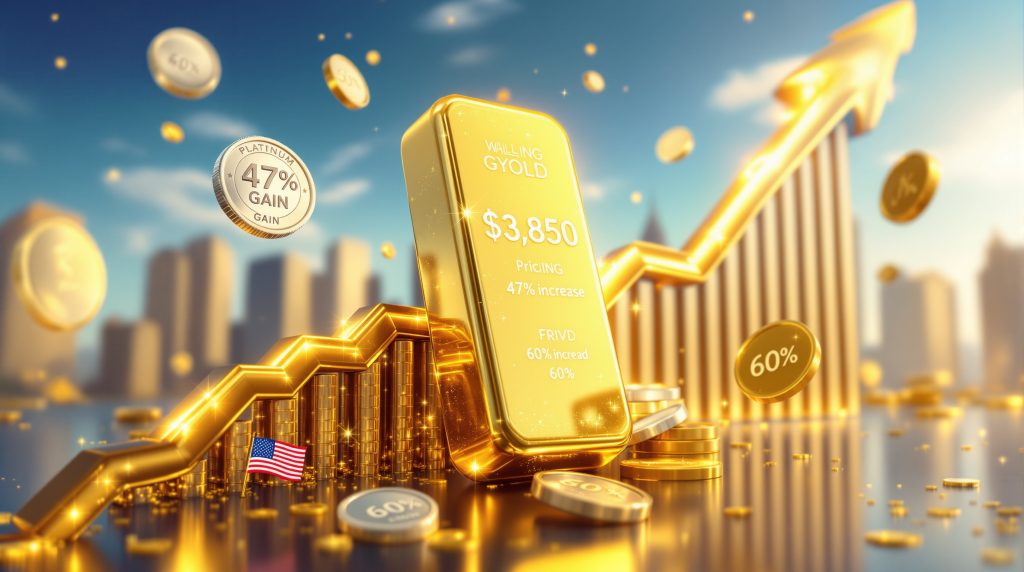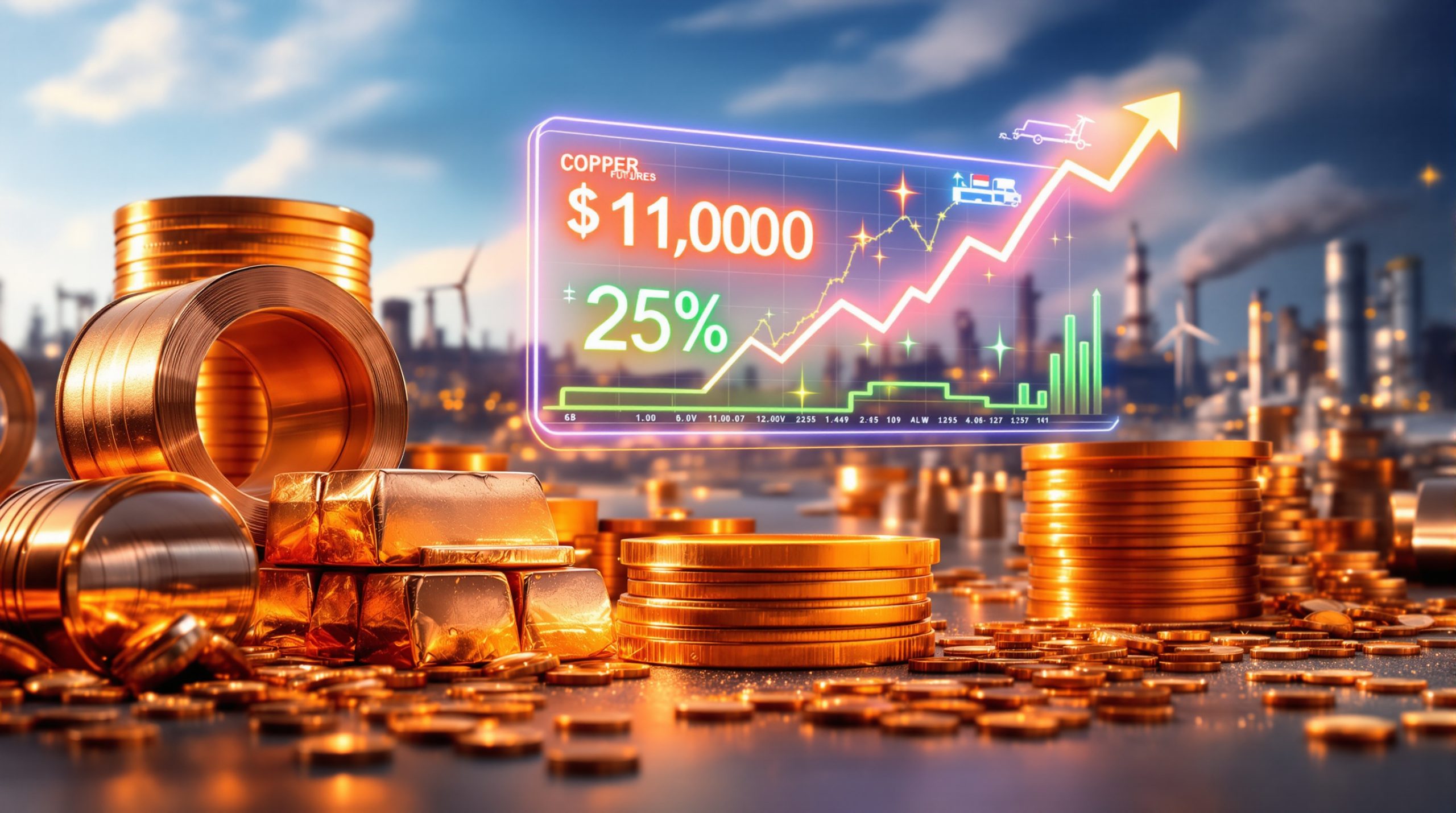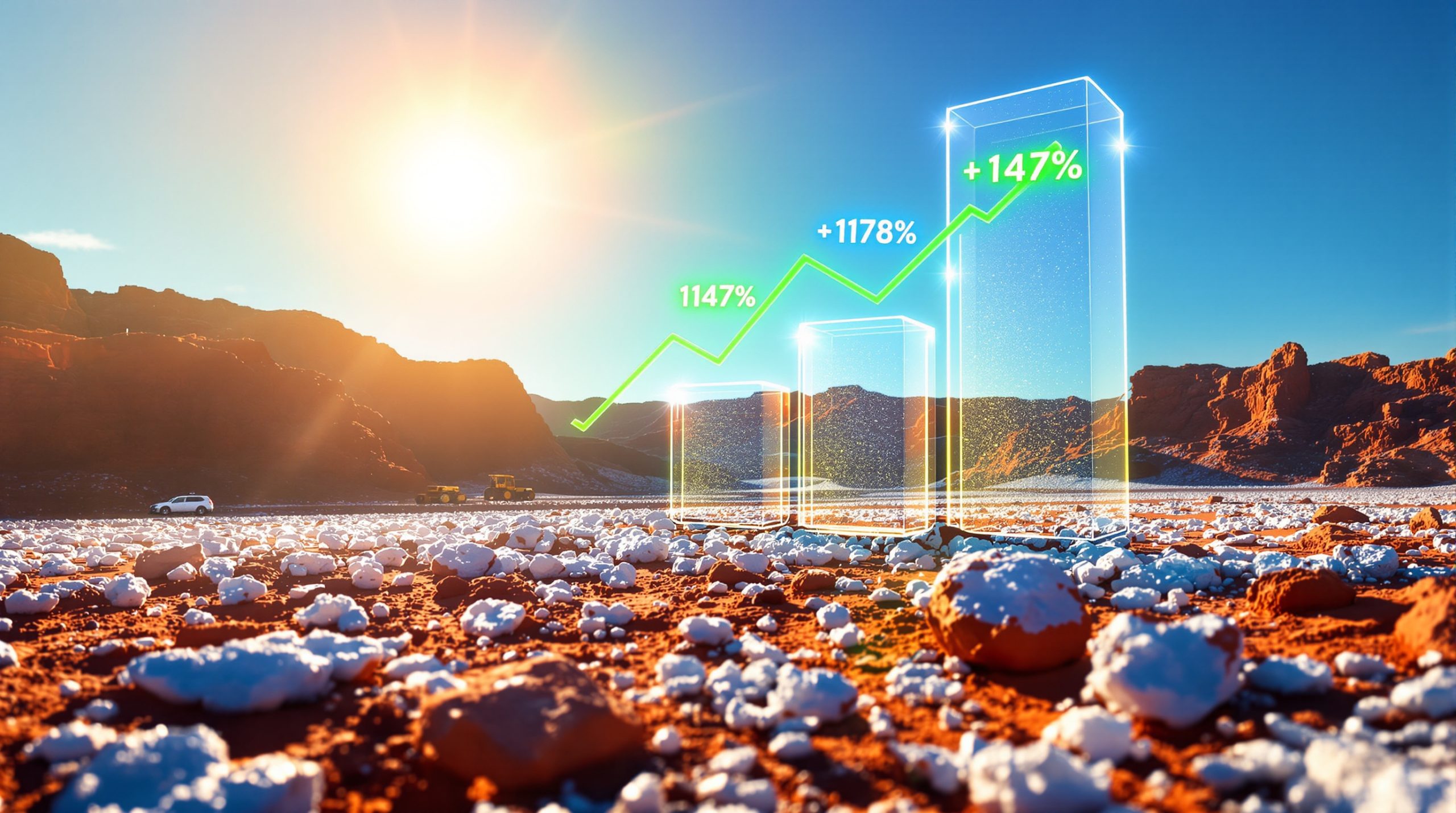What's Driving Gold to Unprecedented Price Levels?
Gold has emerged as the standout performer in financial markets this year, captivating investors globally with its remarkable ascent. The precious metal has demonstrated extraordinary resilience and momentum, pushing through multiple resistance levels to establish new historic benchmarks. This phenomenal rally hasn't materialized in isolation—it's been fueled by a perfect storm of economic conditions and market sentiment.
Global Economic Uncertainty Factors
The precious metals market has responded dramatically to widespread economic instability across major global economies. As traditional financial systems face mounting pressures, gold has reinforced its centuries-old reputation as the ultimate safe-haven asset.
Several key factors have converged to create ideal conditions for gold's impressive performance:
- Currency devaluation concerns have intensified as major central banks continue expansionary monetary policies
- Public debt trajectories in developed economies have reached concerning levels, prompting investors to seek alternatives to government securities
- Banking sector vulnerabilities exposed in regional banking challenges have highlighted systemic fragilities
- Real estate market corrections in key global markets have redirected investment flows toward tangible assets
The inverse relationship between gold prices and the US dollar has been particularly noteworthy throughout 2025. As the greenback has faced headwinds against major currencies, gold has capitalized on this weakness. According to recent Federal Reserve Economic Data, this negative correlation has strengthened substantially during the current rally phase.
Market Insight: While historically gold has shown an approximate -0.4 correlation with the US dollar index, current market conditions have intensified this relationship to nearly -0.7 during peak rally periods.
Inflation concerns continue driving investors toward tangible assets despite central bank interventions. Consumer price data has consistently surprised on the upside across multiple economies, eroding purchasing power and undermining confidence in fiat currencies. This environment has traditionally favored precious metals as inflation hedges.
Central Bank Purchasing Patterns
Perhaps most telling has been the strategic reserve diversification undertaken by global monetary authorities. Central banks worldwide have accelerated their gold acquisition programs, collectively adding substantial tonnage to official reserves.
The World Gold Council's latest data reveals central bank purchases reached 1,037 tonnes in 2023, the second-highest annual total on record. This trend has intensified through 2025, with quarterly acquisition rates consistently exceeding market expectations.
Notable patterns in central bank activity include:
- Geographical diversification of purchasing activity beyond traditional buyers
- Acceleration of acquisition timelines compared to previously announced programs
- Public statements from monetary authorities about reducing dollar dependency
- Incremental increases in allocation percentages within overall reserve strategies
Chinese monetary authorities have been particularly aggressive in their accumulation strategy. While official figures remain opaque, cross-border gold flows indicate substantial increases in Chinese sovereign holdings, creating significant market impact through both direct purchases and mining output retention.
Emerging market central banks have similarly increased their gold allocation percentages, with many publicly announcing targets to double their gold reserves within five years. This represents a strategic shift from previous cycles, where purchases were more measured and discreet.
How High Has Gold Actually Climbed in 2025?
The precious metal's performance has been nothing short of extraordinary, breaking through multiple psychological barriers and challenging analyst projections throughout the year. To fully appreciate the magnitude of this movement, it's essential to examine both the price milestones achieved and the technical characteristics of the rally.
Record-Breaking Price Milestones
Gold has experienced a tremendous price appreciation trajectory in 2025, consistently establishing new gold record highs throughout the year. The market has demonstrated exceptional momentum, particularly during the third quarter, where acceleration patterns intensified dramatically.
The year-to-date appreciation of approximately 30-35% represents one of gold's strongest annual performances in modern market history. This substantial move becomes even more remarkable when considering it follows several years of consolidation and range-bound trading.
When comparing the current bull market to previous cycles, several distinctions emerge:
- Greater price velocity than observed during either the 2011 or 2020 rallies
- Broader market participation across institutional, retail and sovereign investors
- More sustained buying pressure without significant technical corrections
- Stronger fundamental underpinnings related to monetary policy and economic conditions
The market's ability to maintain momentum above key psychological price levels has been particularly noteworthy, suggesting robust underlying demand rather than speculative excess.
Technical Analysis of Gold's Parabolic Movement
From a technical perspective, gold's recent movement exhibits classic parabolic characteristics with accelerating price velocity. The six-week surge period highlighted by analysts shows progressively steepening advance angles on the price chart—a pattern typically associated with powerful market trends approaching potential exhaustion points.
Support and resistance level transformations have been dramatic, with previous ceiling levels quickly becoming floor levels after breakouts. This technical phenomenon, known as polarity principle conversion, indicates exceptional buying pressure on any retracements.
Volume indicators during breakthrough moments have consistently shown expanding participation, confirming the legitimacy of price advances. This contrasts with technically suspect rallies where volume often diminishes as prices extend.
Momentum oscillators present a more nuanced picture regarding sustainability:
- The Relative Strength Index (RSI) has reached extended readings above 70
- The Moving Average Convergence Divergence (MACD) histogram shows widening divergence
- Rate of Change (ROC) measurements indicate potential overextension in the near term
- On-Balance Volume (OBV) continues to confirm price direction with higher highs
These technical factors suggest the potential for consolidation phases within the broader uptrend, though the fundamental drivers remain firmly intact.
Why Are Institutional Investors Flocking to Gold Now?
The substantial shift in institutional positioning toward gold represents one of the most significant market developments of 2025. Traditional portfolio managers have dramatically increased their precious metals exposure, marking a departure from conventional allocation models.
Monetary Policy Influence
Federal Reserve policy expectations have undergone substantial revisions throughout 2025, with markets pricing in multiple interest rate reductions following weaker-than-anticipated employment data. The central bank's pivot toward accommodative policy has created an environment historically favorable for precious metals.
Historical analysis demonstrates a consistent pattern: gold typically performs exceptionally well during monetary easing cycles. This relationship stems from several interconnected factors:
- Lower interest rates reduce the opportunity cost of holding non-yielding assets
- Accommodative policy often coincides with currency devaluation concerns
- Monetary expansion increases inflation expectations over medium-term horizons
- Economic uncertainty driving policy shifts enhances gold's safe-haven appeal
The correlation between real interest rates (nominal rates minus inflation) and gold prices has been particularly noteworthy in the current cycle. As real rates have moved deeper into negative territory, gold's attractiveness has increased proportionally.
Portfolio Allocation Shifts
Institutional positioning changes throughout 2025 have been remarkable both in magnitude and consistency. Fund manager surveys indicate the average portfolio allocation to precious metals has increased from below 2% to approximately 5-7% among diversified managers—a significant repositioning of capital.
Several factors have driven these allocation shifts:
- Risk management imperatives in an increasingly uncertain macro environment
- Correlation benefits as traditional assets show heightened synchronization
- Inflation protection mandates from investment committees and stakeholders
- Momentum-based capital flows following sustained performance
Hedge fund positioning in the futures market has similarly reflected this institutional embrace, with Commitments of Traders reports showing substantial increases in net long positions among managed money participants. This positioning has been maintained despite periodic technical corrections, indicating conviction rather than opportunistic trading.
The long-term investment thesis emerging from major asset managers emphasizes gold's role beyond tactical positioning. Strategic allocation discussions now frequently reference multi-year horizons for precious metals exposure, a significant evolution from previous cycles where gold was often viewed as a temporary safe haven during acute market stress.
How Are Other Precious Metals Performing in Gold's Shadow?
While gold has dominated financial headlines, the broader precious metals complex has experienced remarkable strength. Each metal within this category offers unique characteristics and exposure to different economic factors, creating varied performance patterns despite the common bullish backdrop.
Silver's Impressive Performance
Silver has demonstrated exceptional momentum in 2025, breaking through technical resistance levels that had contained prices for over a decade. This performance represents a complex interplay between investment demand and industrial consumption patterns.
The industrial demand factors supporting silver extend beyond traditional applications into emerging technologies:
- Photovoltaic capacity expansion continues accelerating globally, with silver paste being an essential component in solar panel construction
- Electronics manufacturing requires increasing silver quantities as component miniaturization demands higher conductivity materials
- Medical applications have expanded considerably, with silver's antimicrobial properties finding new healthcare uses
- Electric vehicle production utilizes silver in multiple systems from battery management to connectivity features
The gold-to-silver ratio—a metric tracking the relative value between the two metals—has attracted significant analytical attention. This ratio has contracted substantially from its historical average, indicating silver's outperformance relative to gold. Market historians note that extended precious metals bull markets typically feature this pattern, with silver accelerating as cycles mature.
Supply constraints have further supported price discovery in the silver market. Primary silver mines face declining ore grades and production challenges, while approximately 70% of silver production occurs as a byproduct of other metal mining operations. This supply structure creates limited elasticity in response to higher prices, potentially amplifying upward price movements.
Platinum's Remarkable Annual Gain
Platinum has emerged as perhaps the strongest performer within the precious metals complex in 2025, posting gains that have surprised even bullish analysts. This performance represents a substantial reversal from years of underperformance relative to both gold and palladium.
Several catalysts have driven platinum's outperformance:
- Automotive catalyst demand has recovered more strongly than anticipated following production disruptions
- Industrial application expansion in chemical processing, petroleum refining, and glass manufacturing
- Hydrogen economy development with platinum's essential role in fuel cell catalysts
- Investment demand revival after prolonged underperformance attracted value-oriented capital
Supply chain disruptions and production challenges have further supported the price recovery. South Africa, which accounts for approximately 75% of global platinum production, has faced persistent electricity supply issues and labor challenges, constraining output during a period of rebounding demand.
The investment demand versus industrial consumption balance has shifted notably in the platinum market. While industrial applications remain the dominant source of demand, investment flows have increased substantially as price momentum attracted speculative capital and broadened investor awareness.
What Does Copper's Breakout Suggest About the Broader Economy?
Copper's price action offers valuable insights into global economic conditions given its widespread industrial applications. Often referred to as "Dr. Copper" for its ability to diagnose economic health, the metal's recent performance provides important context for interpreting the broader commodities rally.
Industrial Metal Performance Indicators
Copper has established multi-month highs in 2025, breaking through significant technical resistance levels after an extended consolidation period. This breakout pattern has occurred on expanding volume, suggesting institutional participation rather than merely speculative activity.
The metal's performance can be attributed to several interrelated factors:
- Manufacturing activity indicators showing resilience despite monetary tightening
- Infrastructure investment programs being implemented across major economies
- Inventory levels at major exchanges declining to multi-year lows
- Supply disruptions at key mining operations in major producing regions
Chinese infrastructure investment has been particularly impactful for copper demand. Despite property sector challenges, public spending on electricity distribution networks, transportation infrastructure, and renewable energy projects has maintained robust copper consumption in the world's largest market.
The green energy transition represents a structural demand driver that continues gaining momentum. Copper's essential role in renewable energy systems, battery production, and charging infrastructure creates sustained consumption growth independent of traditional economic cycles.
Economic Growth Signals
Copper's traditional role as an economic barometer offers fascinating insights into current market conditions. Its strength suggests underlying economic resilience despite concerns about slowing growth in major economies.
This creates seemingly conflicting signals between precious and industrial metals:
- Gold strength typically indicates economic uncertainty and risk aversion
- Copper strength generally suggests economic expansion and industrial demand
- Simultaneous strength in both presents an unusual market condition
- Historical precedent for this pattern is limited and outcomes varied
Regional demand variations across major economies help explain this apparent contradiction. Developing economies continue demonstrating robust commodity consumption patterns, while developed markets show more mixed economic indicators. This bifurcated global growth environment creates complex cross-currents in commodity markets.
The forward-looking implications for global growth remain nuanced. Copper's strength suggests manufacturing resilience and infrastructure development continue despite monetary tightening. However, this should be balanced against other indicators showing economic deceleration in certain regions and sectors.
What Trading Opportunities Have Emerged From This Rally?
The extraordinary price movements across the precious metals complex have created both significant opportunities and heightened risks for market participants. Navigating these volatile conditions requires disciplined risk management and awareness of unique market dynamics.
Risk Management Strategies
Position sizing considerations become increasingly critical during volatile market phases like the current precious metals rally. Many professional traders have adjusted their normal position parameters to account for expanded daily ranges and overnight gaps.
Prudent approaches include:
- Reducing standard position sizes by 30-50% compared to normal market conditions
- Implementing wider stop-loss parameters to accommodate increased volatility
- Utilizing options strategies to define maximum risk exposure
- Pyramiding into positions rather than establishing full allocations initially
Stop-loss placement techniques in trending markets require special attention during parabolic price phases. Technical traders have adapted by using multiple timeframe analyses to identify significant support levels, often placing protective stops below consolidation zones rather than using fixed percentage or dollar-based stops.
Profit-taking approaches at record price levels present unique challenges without historical reference points. Scaling out of positions at predetermined intervals has proven effective for many traders, allowing partial gains to be secured while maintaining exposure to potential further upside.
Contract scaling methods offer another dimension of risk management. By utilizing multiple contract sizes (mini, micro, and standard contracts), traders can more precisely calibrate position sizing and implement partial profit-taking with greater flexibility.
Market Liquidity Considerations
The impact of Chinese holiday periods on trading volumes has been particularly notable in the current market environment. With China representing such a substantial portion of global commodity demand, these scheduled liquidity reductions can create exaggerated price movements, especially during the Asia-Pacific trading session.
Volume patterns during breakout phases have shown interesting characteristics:
- Initial breakouts typically occur on substantial volume surges
- Continuation moves often display lower but sufficient confirmation volume
- Climactic price extensions frequently coincide with volume expansion
- Healthy consolidations generally show declining volume patterns
Institutional participation levels during breakout phases can be assessed through various metrics including futures market open interest, ETF flows, and options market activity. These indicators suggest the current rally has broad-based participation beyond speculative retail traders, providing fundamental support for price advances.
Retail investor influence on price discovery has increased substantially in recent years through expanded access to futures markets, metals-backed ETFs, and online precious metals dealers. This democratization of market access has altered traditional liquidity patterns and potentially amplified momentum-driven price movements.
How Might Employment Data Affect Gold's Trajectory?
Economic data releases, particularly employment reports, have emerged as critical catalysts for precious metals price action in the current environment. Understanding these relationships can provide valuable context for anticipating market reactions to upcoming announcements.
Non-Farm Payrolls Impact Analysis
Historical price reactions to employment data releases show consistent patterns based on the relationship between actual results and market expectations. Gold has demonstrated asymmetric response characteristics, with larger positive reactions to disappointing employment data than negative reactions to stronger-than-expected reports.
This relationship stems from the market's focus on Federal Reserve policy implications:
- Weaker employment data increases expectations for accommodative policy
- Stronger employment data reduces immediate easing expectations
- Current market positioning already anticipates policy easing
- Magnitude of surprise relative to consensus becomes the critical variable
The correlation between labor market strength and gold prices operates primarily through this monetary policy transmission mechanism rather than as a direct relationship. This explains why gold can occasionally rally even with positive employment data if other aspects of the report (wage growth, participation rate) suggest economic vulnerability.
Federal Reserve policy response expectations currently indicate a high probability of continued easing through year-end. However, these expectations remain fluid and subject to significant revision based on incoming data. Market participants should monitor changes in these expectations as they often precede price adjustments in interest-rate sensitive assets like precious metals.
Economic Indicator Interpretation Framework
Developing a systematic approach to interpreting economic releases can improve trading decisions during volatile market conditions. This begins with distinguishing between leading and lagging economic indicators and their relative significance for monetary policy decisions.
Employment data represents a lagging indicator—confirming economic trends rather than predicting them. However, its outsized importance for policy decisions makes it a critical market catalyst despite this limitation. Other leading indicators worth monitoring include:
- Purchasing Managers' Indices (PMIs) for manufacturing and services sectors
- Housing market metrics including building permits and mortgage applications
- Consumer confidence surveys and retail sales figures
- Credit market conditions and lending standards
Market sentiment shifts following data surprises can be amplified by algorithmic trading response patterns. These systematic trading programs often execute orders based on headline numbers within microseconds of releases, creating immediate liquidity imbalances that can trigger stop-loss cascades or short-covering rallies.
Positioning adjustments ahead of major announcements have become increasingly common as volatility has expanded. Many traders reduce exposure before significant data releases, creating potential opportunities for those willing to maintain positions through these events with appropriate risk parameters.
What's the Outlook for Gold Through Year-End 2025?
While short-term price movements remain subject to technical factors and event-driven volatility, examining both technical projections and fundamental catalysts can provide a framework for understanding gold's potential trajectory through year-end.
Technical Projection Models
Price target methodologies vary widely among technical analysts, but several approaches have demonstrated historical reliability in trending markets. These include:
- Measured move projections based on the magnitude of previous consolidation phases
- Fibonacci extension levels calculated from significant retracement swings
- Channel projection techniques maintaining established slope trajectories
- Point-and-figure count methods offering price objectives based on consolidation width
Moving average relationships provide important context for trend strength evaluation. The increasing separation between short-term, intermediate, and long-term moving averages indicates exceptional momentum that typically precedes either consolidation or trend deceleration rather than immediate reversal.
Volume profile analysis at key price zones identifies areas of significant historical trading activity that often become important support or resistance levels. These high-volume nodes frequently correspond with psychological price levels and can influence market behavior when revisited.
Fundamental Catalysts to Monitor
Several upcoming events and developments warrant close attention for their potential impact on precious metals markets:
- Central bank policy meetings scheduled through year-end will provide updated guidance on monetary trajectories
- Quarterly corporate earnings results may influence broader risk sentiment and correlative assets
- Geopolitical developments in several regions could trigger safe-haven flows
- Year-end institutional positioning adjustments as portfolio managers finalize annual performance
Inflation trend analysis across major economies continues suggesting persistent price pressures despite monetary tightening efforts. While headline inflation rates have moderated, core measures remain elevated, particularly in service sectors. This dynamic supports the structural case for precious metals exposure as inflation hedges.
Institutional positioning changes and fund flows will likely play an increasingly important role as year-end approaches. Many investment committees make strategic allocation decisions during fourth-quarter meetings, potentially creating substantial capital movements into or out of precious metals investments based on forward expectations.
FAQ: Gold's Record-Breaking Performance
Is gold's current rally sustainable or approaching bubble territory?
The sustainability of gold's rally depends on multiple factors including monetary policy trajectory, inflation developments, and broader market stability. While some technical indicators suggest potential overextension in the near term, fundamental drivers including central bank purchases, persistent inflation concerns, and ongoing economic uncertainty provide substantive support.
Historical comparisons with previous bull markets indicate the current move, while significant, has not yet demonstrated the extreme price velocity or public participation typically associated with speculative bubbles. Healthy bull markets often include periodic consolidations, which may occur without threatening the longer-term uptrend.
How does gold's performance compare to other asset classes in 2025?
Gold has substantially outperformed most traditional asset classes in 2025, including many equity indices, government bonds, and corporate fixed income. This outperformance becomes particularly notable when risk-adjusted returns are considered, with gold delivering superior returns with lower volatility than many alternatives.
The relative performance advantage has been most pronounced against fixed-income investments, where rising yields have created challenging conditions for bond investors. Among commodities, gold's performance has been exceptional but not isolated, with the broader complex showing strength amid global supply constraints and demand resilience.
What role are ETFs playing in the current gold market dynamics?
Gold-backed ETFs have experienced substantial inflows throughout 2025, contributing significantly to overall investment demand. These investment vehicles have democratized precious metals ownership, allowing both retail and institutional investors to gain exposure without physical storage considerations.
The total gold holdings within ETF structures now represent a substantial percentage of above-ground gold stocks, creating a dynamic where ETF flow patterns can influence short-term price action. Institutional investors frequently utilize these vehicles for tactical allocation adjustments, while retail investors favor them for longer-term strategic positions.
How might seasonal patterns affect gold prices in Q4 2025?
Historical seasonal patterns show varied influences on gold during fourth quarters. Traditional jewelry demand typically increases ahead of holiday seasons in Western markets and wedding seasons in major Asian gold-consuming countries like India. This physical demand can provide price support during periods of investment flow uncertainty.
However, in the current environment, investment flows remain the dominant price driver rather than physical consumption patterns. Year-end institutional positioning often creates increased volatility as portfolio managers finalize annual allocations and implement strategic decisions for the coming year, potentially overshadowing traditional seasonal factors.
Ready to Profit From the Next Major Gold Discovery?
Discover investment opportunities in ASX-listed gold explorers before the market reacts, with real-time alerts powered by Discovery Alert's proprietary Discovery IQ model. Explore why historic gold discoveries have generated substantial returns by visiting Discovery Alert's dedicated discoveries page and begin your 30-day free trial today.




